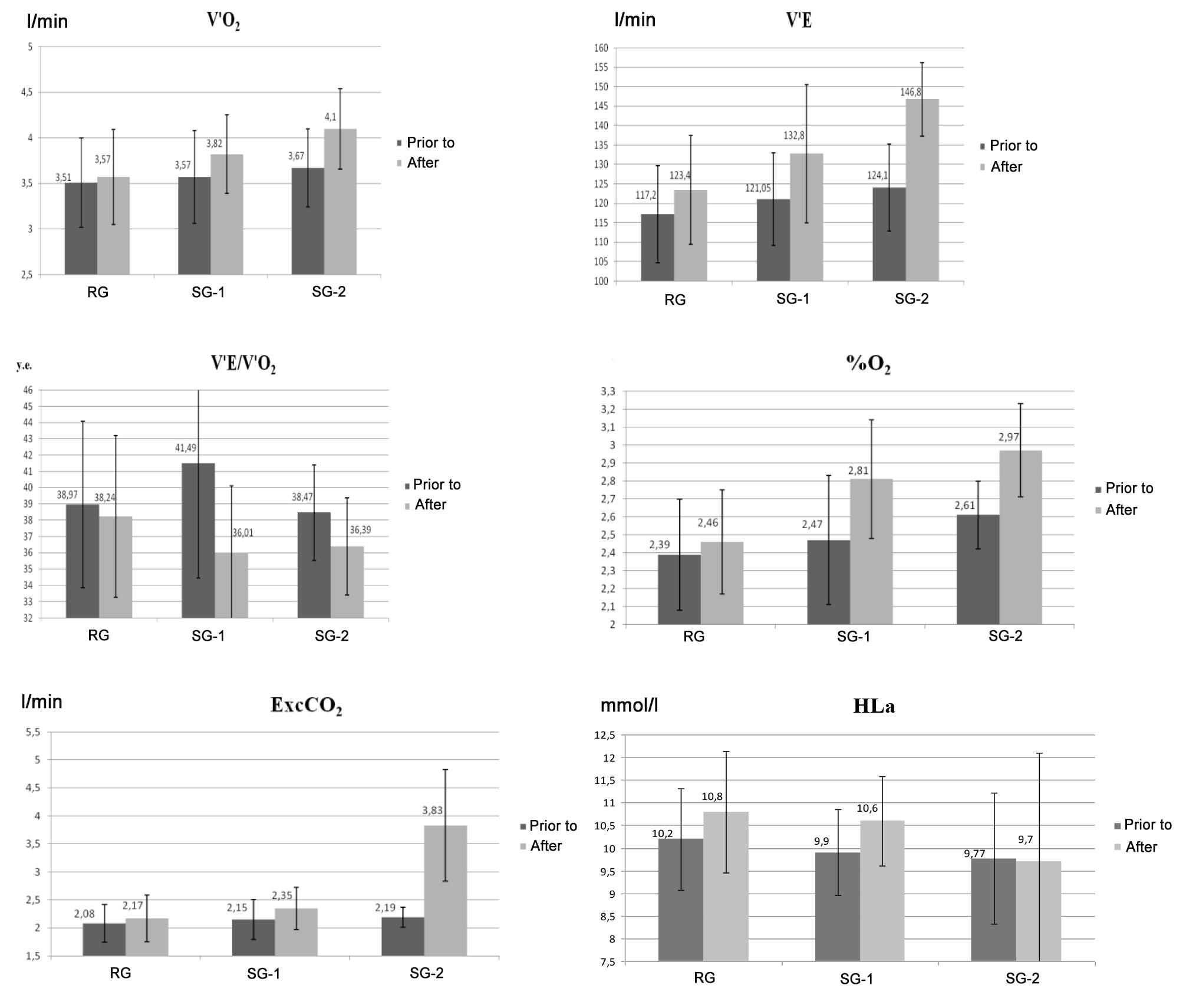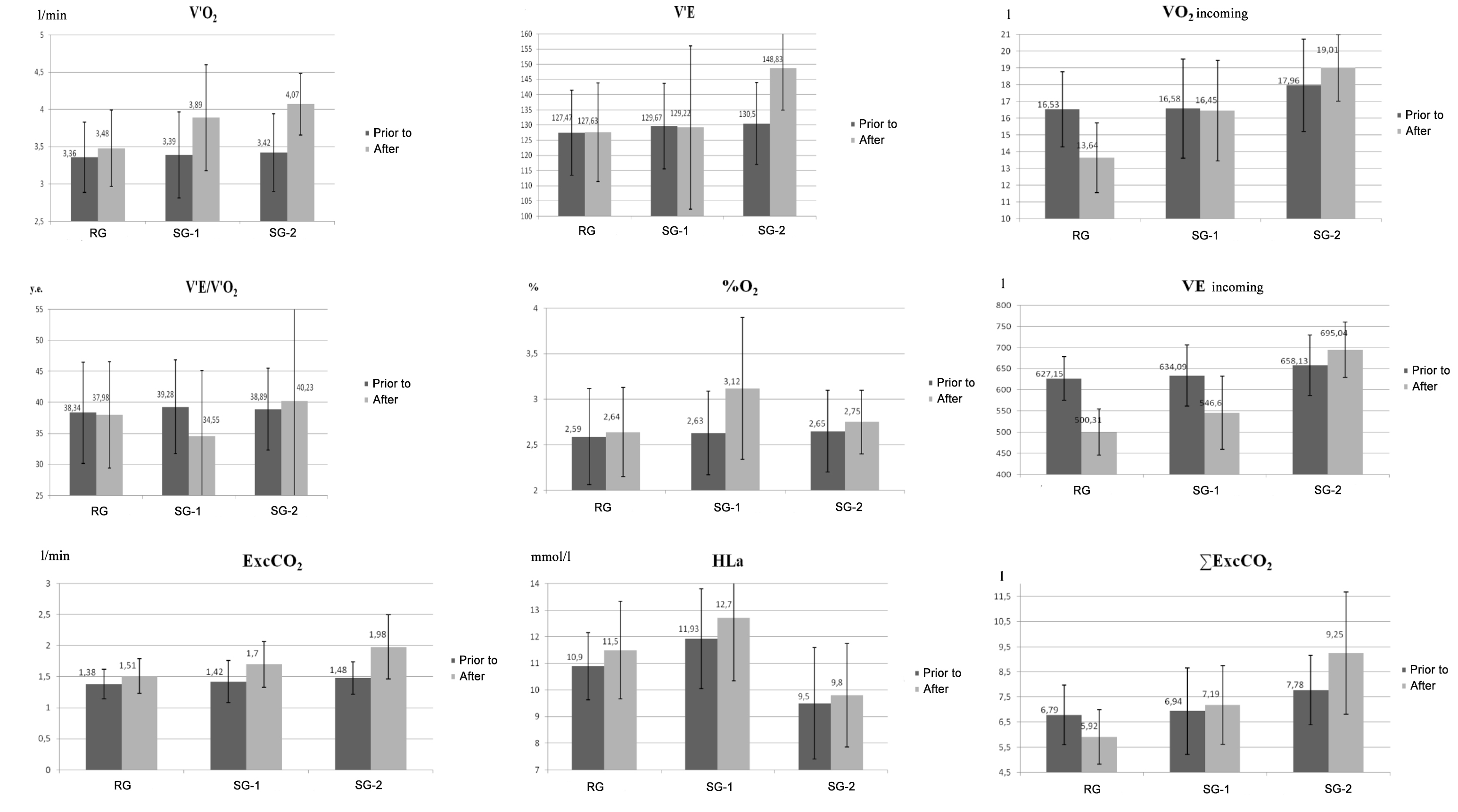Effects of ergogenic training methods on aerobic capacities of junior swimmers
Фотографии:
ˑ:
Dr.Hab., Professor V.R. Solomatin1
Associate Professor, PhD Y.L. Voytenko1
Postgraduate A.V. Egorov1
1Russian State University of Physical Education, Sport, Youth and Tourism (GTSOLIFK), Moscow
Keywords: junior swimmers, aerobic and anaerobic work capacity, capacities, ergogenic training tools.
Background. Top priority has always been given to training process design in the skilled swimmers’ training process [1, 3-6]. The modern athletic training methods and tools are so multiple and versatile that have effectively raised the training and competitive performance to the upper limit of the natural human capacities [1, 5-8]. This is the reason for a variety of new systems being designed and tested to improve the performance efficiency, and the ergogenic training tools are among them. They are designed to expand the dead space by applying extra resistance to the respiration process and creating hypoxic and hyper-hypoxic conditions in different combinations in the process [2].
Objective of the study was to rate benefits of the systemic hyper-hypoxic training with the special respiratory system being applied to improve the aerobic capacities of 15-17 years-old swimmers in the pre-season.
Methods and structure of the study. Subject to the experiment were 36 swimmers (Class I Athletes and Candidate Masters of Sport). The experimental training course lasted for 5 weeks in the pre-season, the basic training system being the same for every athlete. We formed 3 groups of 12 people each. The Reference Group (RG) was trained as usual, without the respiratory system; the Study Groups 1 and 2 (SG-1 and SG-2) were trained with application of the respiratory system, with the respiratory system application taking up to 40% of the training workload in the SG-2.
Prior to and after the training cycle the subjects were tested by the following treadmill tests:
- Treadmill graded exercise tests; and
- Submaximal treadmill exercise tests.
The above tests were designed to generate the following test rates: maximal oxygen consumption rate, lung ventilation rate, excess non-metabolic CO2, oxygen utilization rate and lactic acid level.
Study results and discussion. The treadmill graded exercise tests found the aerobic capacity rates being increased in all the three groups, with the maximal oxygen consumption rates (see Figure 2) growing most significantly in SG-2 (from 3.67±0.43 l/min to 4.1±0.44 l/min, р≤0.05). The growth rates in SG-1 and RG were insignificant (from 3.57±0.51 l/min to 3.82±0.43 l/min, р≥0.05; and from 3.51±0.49 l/min to 3.57±0.52 l/min, р≥0.05, respectively).
Aerobic capacity is known to directly correlate with the lung ventilation rate indicative of the efficiency of the respiratory organs responsible for the current supply of oxygen to the body. The lung ventilation rate in SG-2 was found to significantly grow (from 124.1±11.2 l/min to 146.8±9.5 l/min, р≤0.01) which is indicative of the highly positive effect of the training with the respiratory system on the athletes’ respiratory capacities. In SG-1 the lung ventilation rate growth was less expressed (from 121.1±11.9 l/min to 132.8±17.8 l/min, р≥0.05), and the same applies to the RG (with the growth from 117.2±12.47 l/min to 123.4±14.02 l/min, р≥0.05).
External respiration process efficiency is well rated by a ventilation equivalent rate that shows the inspiratory volume required to utilize 1 ml of oxygen. In the RG, this rate was found to stay virtually the same in the experiment (varying from 38.97±5.12 to 38.24±4.97, р≥0.05). In the Study Groups, the rate was found to significantly fall as follows: in SG-1 from 41.49±7.03 to 36.01±4.11, р≤0.05; and in SG-2 from 38.47±2.93 to 36.39±2.98, р≤0.05. The ventilation equivalent rate decrease was interpreted as indicative of the respiratory efficiency being improved.

Figure 1. Treadmill graded exercise test rates prior to and after the experiment in three groups of junior swimmers
The simultaneous growth of the oxygen utilization rate and lung ventilation rate are characteristic of the growing efficiency of the external respiration and tissue respiration apparatus. The oxygen utilization rates in the Study Groups were found to significantly grow (in SG-1 from 2.5±0.4% to 2.8±0.3%, р≤0.05; and in the SG-2 from 2.6±0.2% to 3.0±0.3%, р≤0.01). In the RG the growth was insignificant: from 2.4±0.3% to 2.5±0.3%, р≥0.05. The tests showed the aerobic oxygen supply being more efficient in the athletes who applied the respiratory system in the training process.
In these tests, the glycolytic anaerobic capacity rate may be measured by the expiratory “non-metabolic excess” of the carbon dioxide (ExcCO2) which is known to closely correlate with the maximum levels of lactic acid generated by glycolytic process in the working muscles, the extra carbon dioxide being produced in excess of the levels of tissue metabolism. In RG and SG-1, the variations were found insignificant (from 2.08±0.34 l/min to 2.17±0.42 l/min, р≥0.05; and from 2.2±0.4 l/min to 2.4±0.4 l/min, р≥0.05, respectively). In SG-2 the ExcCO2 rates were found to notably grow from 2.2±0.2 l/min to 3.8±1 l/min, р≤0.05. It was interpreted as indicative of the hyper-hypoxic conditions created by the respiration system stepping up the anaerobic metabolism and advancing the glycolytic mechanisms of the energy supply to the working body.
The lactic acid levels prior to and after the experimental training course were found virtually the same (in the RG they varied from 10.2±1.12 mmol/l to 10.8±1.34 mmol/l, р≥0.05; in SG-1 from 9.9±0.95 mmol/l to 10.6±0.99 mmol/l, р≥0.05; and in SG-2 from 9.77±1.45 mmol/l to 9.7±2.39 mmol/l, р≥0.05). The working capacity growth with the lactic acid levels staying virtually the same was interpreted as indicative of the growth in the energy efficiency and fitness levels.
The oxygen consumption rates in the submaximal treadmill exercise tests were found to significantly grow in both of the Study Groups (see Figure 2). However, the SG-2 athletes trained using the respiratory systems showed the higher oxygen utilization growth rates than those in SG-1 and RG: in SG-2 the rate grew from 3.42±0.52 l/min to 4.07±0.41 l/min, р≤0.01; versus the SG-1 growth from 3.39±0.58 l/min to 3.89±0.71 l/min, р≤0.05; and the RG growth from 3.36±0.47 l/min to 3.48±0.51 l/min, р≥0.05.

Figure 2. Rates in submaximal treadmill exercise test prior to and after the experimental training course in the junior swimmers of the three groups
Therefore, the SG-2 athletes were tested with the higher aerobic capacity rates in these tests. In RG and SG-1, the lung ventilation rates did not show any significant variations. The respiration functionality was found to significantly improve after the training course only in SG-2 (in RG the rate varied from 127.47±13.97 l/min to 127.63±16.21 l/min, р≥0.05; in SG-1 from 129.67±14.08 l/min to 129.22±26.86 l/min, р≥0.05; and in SG-2 from 130.5±13.44 l/min to 148.83±13.9 l/min, р≤0.01). These test data were interpreted as indicative of the respiratory system applied in the training process being of highly positive effect on the aerobic capacity and external respiratory functions.
In all the three groups the ventilation equivalent rates were found to stay virtually the same (in RG it varied from 38.34±8.14 to 37.98±8.59, р≥0.05; in SG-1 from 39.28±7.57 to 34.55±10.59, р≥0.05; and in SG-2 from 38.89±6.59 to 40.23±15.61, р≥0.05).
The oxygen utilization rates in all the three groups tended to increase after the experiment (in RG from 2.59±0.53% to 2.64±0.49%, р≥0.05; in SG-1 from 2.63±0.46% to 3.12±0.78%, р≥0.05; and in SG-2 from 2.65±0.45% to 2.75±0.35%, р≥0.05).
The inspiratory VO2 characteristic of the bodily oxygen utilization capacity was found to insignificantly grow only in SG-2 from 17.96±2.76 l to 19.01±1.98 l, р≥0.05 (see Figure 2). Furthermore, ЕхсСО2, the anaerobic glycolytic capacity rate, was found to significantly grow only in SG-2 trained using the respiratory system - from 1.48±0.26 l/min to 1.98±0.52 l/min, р≤0.05 (see Figure 2). This finding was once again supportive of the benefits of the respiratory system in activating the anaerobic energy supply mechanism. Lower lactic acid levels of the SG-2 swimmers were also interpreted as indicative of the higher anaerobic capacity (see Figure 2).
The functionality growth rates in the SG-2 swimmers who applied special exercises with the breathing trainer notably contributed to the improvement of the competitive success rates of the group in 400 m, 800 m and 1500 m events (by 14.4 s ± 3.5 s; 23.8 ± 6.7 s and 35.7 ± 11.5 s, respectively).
Conclusion. The special hyper-hypoxic training exercises using the respiratory system in the pre-season training cycle were provided efficient as verified by the expressed cumulative effects of the training process in general and notable growth of the competitive success rates in particular.
References
- Voytenko J.L. Dinamika trenirovochnykh nagruzok i rabotosposobnosti yunykh plovtsov. Avtoref. diss. kand. ped. nauk [Dynamics of training loads and performance of junior swimmers. PhD diss. abstract]. Moscow,1985, 22 p.
- Volkov N.I. Gipoksiya i anaerobnaya proizvoditelnost sportsmenov [Hypoxia and anaerobic performance of athletes]. Akklimatizatsiya i trenirovka sportsmenov v gornoy mestnosti [Athletes' acclimatization and training in the highlands]. Alma-Ata, 1965, p. 103.
- Solomatin V.R., Bulgakova N.Zh., Zhuravik A. Srochny trenirovochny effekt i sistematizatsiya spetsialnykh trenirovochnykh uprazhneniy v zavisimosti ot urovnya razvitiya aerobnykh i anaerobnykh vozmozhnostey plovtsov vysokogo klassa [Urgent training effect and systematization of special training exercises with regard to level of aerobic and anaerobic capacities of elite swimmers]. Teoriya i praktika fiz. kultury, 1996, no. 1, pp. 37-39.
- Solomatin V.R., Vovk E. E. Otsenka perspektivnosti yunykh plovchikh na osnove ucheta ikh biologicheskoy zrelosti, fizicheskogo i funktsionalnogo razvitiya [Assessment of prospects of junior female swimmers based on their biological maturity, physical and functional development]. Fizicheskaya kultura: vospitanie, obrazovanie, trenirovka, 1997, no. 2, pp. 42-45.
- Solomatin V.R. Kriterii srochnogo trenirovochnogo effekta spetsialnykh uprazhneniy i individualizatsiya podgotovki plovtsov vysokoy kvalifikatsii [Criteria for urgent training effect from special exercises and individualization of training in elite swimming]. Teoriya i praktika fiz. kultury, 2008, no. 10, pp. 68-71.
- Solomatin V.R. Individualizatsiya mnogoletney trenirovki v sportivnom plavanii [Individualization of long-term training in competitive swimming]. Moscow: Fizicheskaya kultura publ., 2009, 241 p.
- Solomatin V.R. Srochny trenirovochny effekt i sistematizatsiya spetsialnykh uprazhneniy v zavisimosti ot urovnya razvitiya funktsionalnykh vozmozhnostey plovtsov vysokogo klassa [Urgent training effect and systematization of special exercises with regard to functionality level of elite swimmers]. Uchenye zapiski un-ta im. P. F. Lesgafta, 2009, no.10 (56), pp. 97-101.
- Solomatin V.R. Variativnost srochnykh trenirovochnykh effektov kak osnova sistematizatsii spetsialnykh uprazhneniy plovtsov [Variability of urgent term training effects as a basis for systematization of special exercises in competitive swimming]. Vestnik sportivnoy nauki, 2010, no. 2, pp. 25-27.
Corresponding author: nosorog52@mail.ru
Abstract
The study was designed to assess training effects of breathing trainer on the performance rates of 15-17-year-old swimmers. Subject to the experiment were 36 highly skilled swimmers. Prior to and after the training cycle the subjects were tested by laboratory tests including the treadmill graded exercise test and submaximal treadmill exercise test, with a variety of test rates being measured in the process including VO2max, VE, ExcCO2 etc. It was found that the respiratory system application in the pre-season helped notably increase the aerobic and anaerobic work capacities of junior swimmers and thereby improve their competitive success rates in the middle- and long-distance events.




